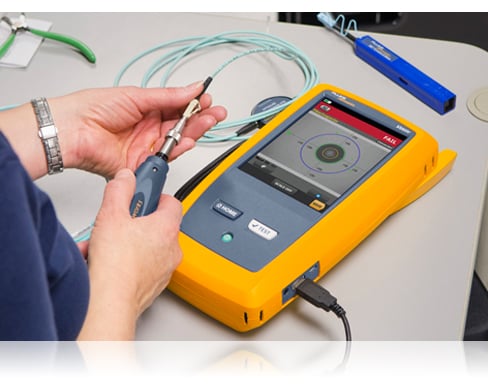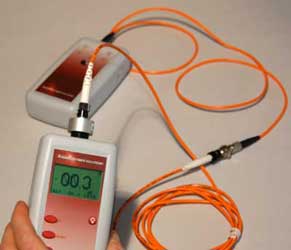The latest optical fibre diameter analyser improves fibre optic research and development.
The latest optical fibre diameter analyser improves fibre optic research and development.
Blog Article
Discover the Significance of Optical Fiber Testing in Modern Telecom
In the realm of modern-day telecoms, the relevance of optical fiber screening can not be overemphasized, as it functions as the foundation for ensuring network integrity and efficiency. By carrying out routine testing protocols, drivers can preemptively determine possible issues such as signal destruction, therefore protecting against disruptions that could verify expensive. Advanced strategies like Optical Time-Domain Reflectometry play a critical duty in this process, yet lots of might neglect the wider effects of these techniques. What are the certain advantages that routine screening offers, and exactly how might it shape the future landscape of telecommunications?

Recognizing Optical Fibre Screening
Optical fibre testing is a critical process in telecommunications that guarantees the honesty and performance of fibre optic networks. This testing encompasses a series of treatments developed to assess the physical and useful characteristics of optical fibres - optical fibre testing equipment. Secret criteria evaluated include optical power loss, data transfer capacity, and mistake area, which are essential for maintaining top quality communication links
The screening procedure normally involves using specialized equipment such as Optical Time-Domain Reflectometers (OTDR) and Optical Power Meters. OTDRs are utilized to identify and characterize faults, splices, and connectors within the fibre, while power meters determine the transmitted light signal stamina to ascertain performance.
In addition, testing is performed at different phases, including during installment, upkeep, and troubleshooting, to ensure that the network meets market criteria and operational needs. Conformity with requirements established by organizations like the International Telecommunication Union (ITU) and the Telecommunications Market Organization (TIA) is vital.
Advantages of Routine Checking
Regular testing of optical fibers yields many advantages that significantly enhance network reliability and efficiency. One of the key advantages is the very early discovery of potential concerns, such as breaks or degradation in the fibre, which can bring about expensive downtime if left unaddressed (fibre testing equipment). By determining these issues proactively, telecommunications suppliers can lessen service disturbances and make sure regular connectivity for their clients
In addition, routine screening aids to keep the honesty of signal quality. As optical fibers age, their performance can be influenced by factors such as ecological conditions and physical tension. Routine assessments enable for the surveillance of signal loss and general transmission effectiveness, guaranteeing that the network operates at optimal degrees.
An additional substantial advantage is conformity with industry standards. Routine testing supports adherence to regulative demands, thus reducing legal and monetary threats related to non-compliance. Additionally, it enhances the general lifespan of the fibre facilities by helping with prompt upkeep and repair services.

Common Checking Methods
Evaluating optical fibers uses different methods to guarantee the integrity and efficiency of telecoms networks. Amongst one of the most typical techniques is Optical Time Domain Name Reflectometry (OTDR), which look at more info assesses the entire length of the fibre by sending out a pulse of light and measuring the representations brought on by blemishes or breaks. This approach gives comprehensive details concerning the area and seriousness of mistakes.
An additional prevalent technique is the use of Optical Power Meters, which gauge the amount of light sent through the fibre. This technique assists determine the loss of signal stamina, ensuring that it meets industry criteria. In Addition, Aesthetic Fault Locators (VFL) are employed to recognize breaks or extreme bends in the fibre by projecting a noticeable laser light into the wire.
Insertion loss screening is likewise important, as it quantifies the loss of signal power arising from connections and entwines within the network. Additionally, the use of Polarization Setting Dispersion (PMD) screening evaluates the impact of fibre attributes on signal stability.
Each of these techniques plays an important function in maintaining the performance and integrity of optical fiber networks, eventually adding to smooth telecommunications procedures.
Influence on Network Performance
The integrity and performance of optical fibre networks straight influence overall network performance. In modern telecommunications, the efficiency of information transmission counts greatly on the high quality of the optical fibers utilized. Any degradation in the fibre's problem-- whether because of physical damage, contamination, or extreme flexing-- can lead to raised attenuation and signal loss, dramatically affecting information honesty and rate.
Regular optical fiber testing is necessary to identify and fix possible concerns prior to they materialize as network failures or stagnations. Strategies such as Optical Time Domain Name Reflectometry (OTDR) and insertion loss testing make it possible for service technicians to measure the performance of fiber links accurately. These tests not just examine the click to read physical condition of the fibres yet additionally guarantee compliance with sector criteria, thereby guarding the network's reliability.
Furthermore, a well-kept optical fibre network adds to reduced functional costs and enhanced customer contentment, as end-users experience fewer disturbances and greater data rates. Eventually, the emphasis on extensive optical fiber testing techniques works as a keystone for maintaining robust telecoms framework, guaranteeing that provider can satisfy the growing needs for data transfer and connectivity in today's electronic age.
Future Fads in Testing
As we look ahead, innovations in innovation are positioned to reshape optical fibre testing in telecoms. The surge of automation and expert system (AI) is expected to enhance the efficiency and precision of testing processes. Automated testing systems can carry out comprehensive evaluations with marginal human intervention, significantly minimizing the capacity for errors and speeding up time-to-deployment.
Furthermore, the assimilation of maker learning formulas will certainly allow anticipating maintenance, permitting network providers to predict prospective concerns before they intensify into failures. This proactive strategy not just enhances network integrity yet also optimizes functional costs.
Another arising fad is the development of portable screening gadgets that offer real-time evaluation - optical fibre testing equipment. These tools will equip professionals to carry out on-site diagnostics rapidly, promoting quicker resolutions and enhancing service top quality
The development of 5G networks even more requires the development of screening techniques. As transmission capacity demands enhance, typical testing strategies may no longer suffice. Innovative solutions such as optical time-domain reflectometry (OTDR) and progressed spectral evaluation will become essential in making certain the visit this web-site honesty and performance of high-speed connections.

Final Thought
Finally, optical fibre screening is vital for making sure the stability and integrity of modern telecommunications networks. Regular screening practices not just aid determine potential concerns such as signal loss and mistakes yet also add to enhanced network performance and customer satisfaction. As the demand for seamless connectivity proceeds to expand, the adoption of innovative screening techniques will play a critical role in maintaining high-quality network requirements and supporting the developing landscape of telecommunications.
Report this page